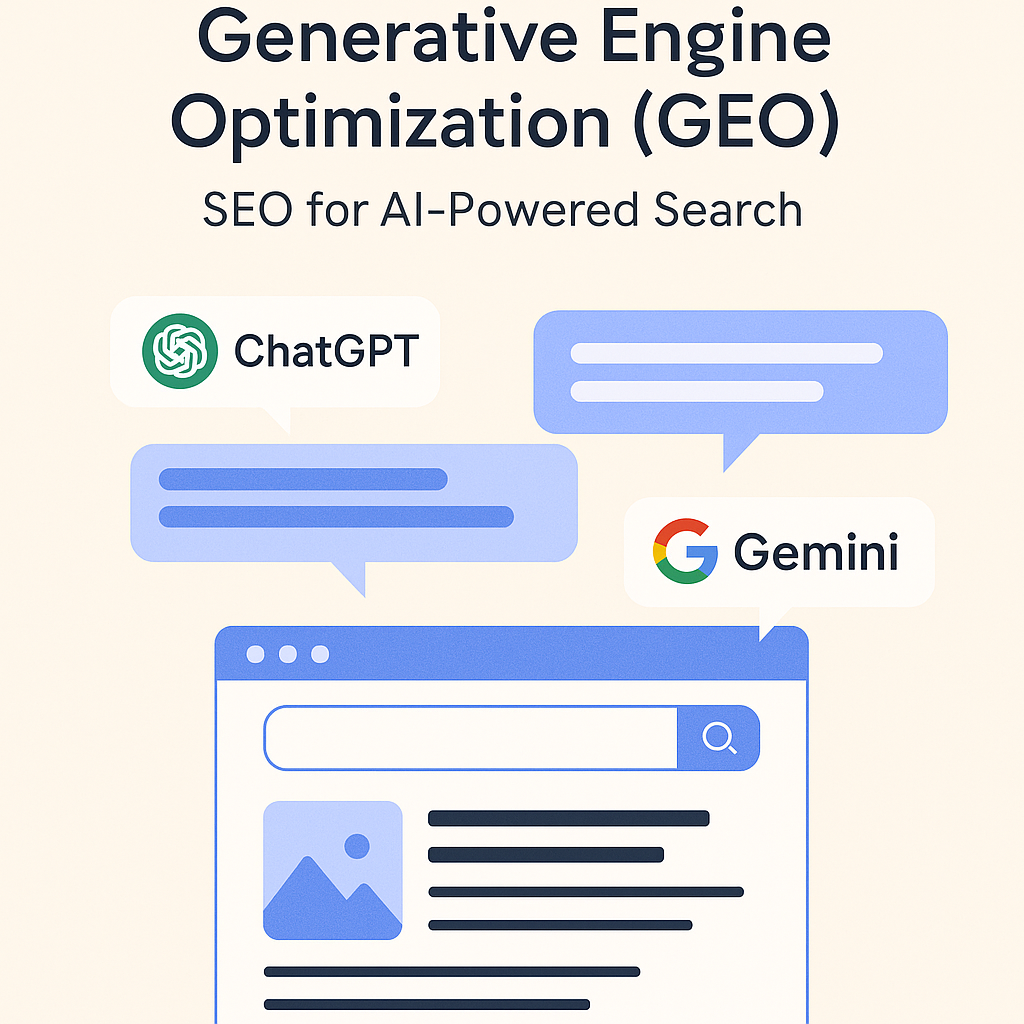🌐 Introduction
The way people search online is changing fast. Traditional search engines are being replaced—or enhanced—by AI tools like ChatGPT, Google Gemini, and Perplexity, which deliver instant, conversational answers instead of just links. As this shift continues, businesses and content creators need a new approach to SEO—one that ensures their content is discoverable by AI-driven platforms. This is where Generative Engine Optimization (GEO) comes in. GEO is the future of search optimization, helping you position your content directly within AI-generated responses. In this blog, we’ll explore what GEO is, why it matters, and how to implement it to stay visible in the age of AI search.
1. What Is Generative Engine Optimization (GEO)?
Generative Engine Optimization (GEO) is the process of optimizing content so it appears in AI-generated search results, rather than just traditional search engine listings. As tools like ChatGPT, Google Gemini, and Perplexity AI provide direct answers to user queries, GEO focuses on helping your content get selected, cited, or referenced by these AI-driven platforms.
Unlike traditional SEO, which targets keyword rankings and SERP positions, GEO is about training large language models (LLMs) to recognize your content as accurate, trustworthy, and relevant. This means writing with clarity, structure, and factual accuracy, so AI engines can easily understand and use your content to form high-quality responses.
In short, **GEO helps your content become the answer—**not just part of the search results.
2. Why Generative Engine Optimization (GEO) Is Essential in 2025
In 2025, the way people search online has drastically changed. AI-powered tools like ChatGPT, Google Gemini, Perplexity AI, and Microsoft Copilot are now answering user queries directly, without requiring them to click on traditional blue links. This shift has led to a rise in zero-click searches, where users get the information they need instantly from an AI-generated response.
That means if your content isn’t optimized for these AI systems, it may be completely invisible to your audience, even if it ranks well in Google’s traditional search results.
Here’s why GEO is critical this year:
- AI is the new search engine: LLMs are becoming the first stop for users looking for fast, reliable answers.
- Traditional SEO alone is not enough: Ranking #1 in Google doesn’t guarantee your content will be used in AI answers.
- Brand visibility depends on content clarity: Only content that’s factual, well-structured, and authoritative is chosen by AI engines.
- Voice and conversational search are booming: More users are searching with natural language questions, which generative engines are designed to handle.
To stay relevant in 2025 and beyond, businesses, creators, and marketers must embrace Generative Engine Optimization to ensure their content is discoverable, trustworthy, and used in the new AI-driven search experience
3. SEO vs GEO: A Modern Comparison
As search evolves, it’s important to understand how Generative Engine Optimization (GEO) differs from traditional SEO. While both aim to increase content visibility, they target very different search behaviors and platforms.
Here’s a side-by-side comparison to show the shift:
| Feature | Traditional SEO | Generative Engine Optimization (GEO) |
| Goal | Rank in Google SERPs | Appear in AI-generated answers |
| Search Platform | Google, Bing, Yahoo | ChatGPT, Google Gemini, Perplexity, Copilot |
| Focus | Keywords, backlinks, meta tags | Semantic clarity, factual accuracy, trust |
| User Intent | Clicking through to a webpage | Getting immediate, direct answers |
| Content Format | Long-form, keyword-rich content | Concise, structured, and answer-ready content |
| Ranking Factors | CTR, bounce rate, on-page SEO, backlinks | Semantic clarity, factual accuracy, and trust |
| Measurement | SERP rankings, organic traffic | Brand mentions, AI citations, zero-click visibility |
Key Takeaway:
SEO helps you rank. GEO helps you get referenced.
If your content isn’t optimized for how AI generates responses, even a #1 Google ranking won’t guarantee you’ll show up in AI answers.
To succeed in both worlds, you’ll need to balance traditional SEO with GEO techniques—future-proofing your visibility across both search engines and generative platforms.
4. Implementing GEO: A 3‑Phase Strategy
To effectively optimize your content for Generative Engine Optimization (GEO), you need a structured approach. GEO isn’t just about keywords—it’s about clarity, credibility, and being answer-worthy. Below is a 3-phase strategy to help you implement GEO successfully.
Phase 1: Foundation – Structure and Clarity
Before your content can be used by AI models, it must be easily understood.
- Write with questions in mind: Use H2/H3 headers that reflect real user queries.
- Give direct answers first: Start each section with a concise 1–2 sentence summary.
- Use plain language: Avoid jargon; AI favors content that’s simple and factual.
- Organize semantically: Break content into clear, logical sections that AI can scan and extract from.
🛠 Tools:
- Hemingway Editor (for readability)
- Frase or Clearscope (for structure and SEO clarity)
Phase 2: Optimization – Trust and Topical Authority
AI models prioritize content from trusted sources. Build your authority:
- Use schema markup: Add Article, FAQ, Author, and HowTo schemas to your blog posts.
- Build internal topic clusters: Link related content together to show expertise in a specific subject.
- Add expert authorship: Include an author bio with credentials to build E-E-A-T (Experience, Expertise, Authoritativeness, Trust).
- Cite credible sources: Link to high-authority external references to support your claims.
🛠 Tools:
- Yoast SEO or Rank Math (schema + SEO setup)
- Google Search Console (for indexing & authority checks)
Phase 3: Visibility – AI Readiness and Monitoring
After content is published, you need to monitor how and where it’s used in AI responses.
- Test your content in AI tools: Ask ChatGPT, Perplexity, and Gemini questions your content answers—see if it’s cited.
- Track branded queries: Set up alerts for mentions of your site or brand in AI answers.
- Continuously refresh content: AI tools prefer up-to-date, accurate, and regularly updated pages.
- Monitor engagement: Use analytics to track time-on-page and referral sources from AI tools.
🛠 Tools:
- ChatGPT, Gemini, and Perplexity (for live testing)
- Google Alerts, Mention.com (for tracking citations)
✅ Final Tip:
Think like the AI. Ask yourself: If I were an AI assistant, would I trust and use this content to answer a user’s question?
5. Tools & Examples
- Perplexity & ChatGPT – Test how AI sources your content.
- Schema Generators – Structured Data Markup Helper, plugin tools.
- Content Editors – Hemingway, Grammarly for clarity.
- SEO Analytics – Ahrefs, SEMrush for long-tail conversational queries.
- Link & PR Tools – HARO, Press releases for brand mentions.
6. Real-World Results
The rise of Generative Engine Optimization (GEO) isn’t just theory — businesses and creators are already seeing tangible benefits by adapting their SEO strategies to AI-powered search engines.
Case Study 1: Tech Blog Boosts Traffic by 40%
A leading technology blog restructured its content using GEO principles: adding clear Q&A sections, implementing schema markup, and focusing on concise, fact-based answers. Within six months, their organic traffic from AI-driven platforms like Bing AI and Google’s SGE increased by 40%, with a significant rise in brand mentions in AI responses.
Case Study 2: E-commerce Site Gains AI Visibility
An e-commerce site optimized its product descriptions and FAQ pages to target conversational queries often asked via voice and chat assistants. As a result, their products began appearing in AI-generated shopping recommendations and answer boxes, resulting in a 25% increase in sales and a boost in customer engagement.
Industry Trends
- Over 65% of search queries in 2025 are expected to come from voice or AI-powered sources.
- Zero-click searches now account for more than 55% of total online queries globally.
- Brands actively optimizing for GEO report higher brand trust and increased direct traffic.
By embracing GEO, businesses not only maintain visibility but also gain a competitive advantage in the rapidly evolving search landscape. The data proves: those who adapt early reap the rewards.
7. Generative Engine Optimization (GEO) Optimization Checklist
✅ Intro summary + keyword mention
✅ Headings with conversational questions
✅ Inline citations and bold stats
✅ JSON‑LD schemas (Article, FAQ)
✅ Modular content blocks
✅ Quotes from experts/studies
✅ Fast, mobile‑friendly, HTTPS
✅ llms.txt file
✅ Promote brand mentions and PR links
✅ Monitor AI citations weekly
Conclusion
Generative Engine Optimization (GEO) is the future of content visibility. As AI-generated answers become mainstream, being the source behind those answers matters more than ever. With clear structure, authoritative signals, modular content, schema, and technical excellence, you can stake your claim in the AI-driven results of tomorrow.
Helps define GEO clearly for both search engines and AI assistants.
Highlights contrast between citation-based AI optimization vs. keyword rankings
Emphasizes the importance as AI assistants become primary search tools
Focuses on on‑page structure: conversational Q&A, schema markup, FAQ formatting
Explains how Answer Engine Optimization complements GEO for full AI visibility



